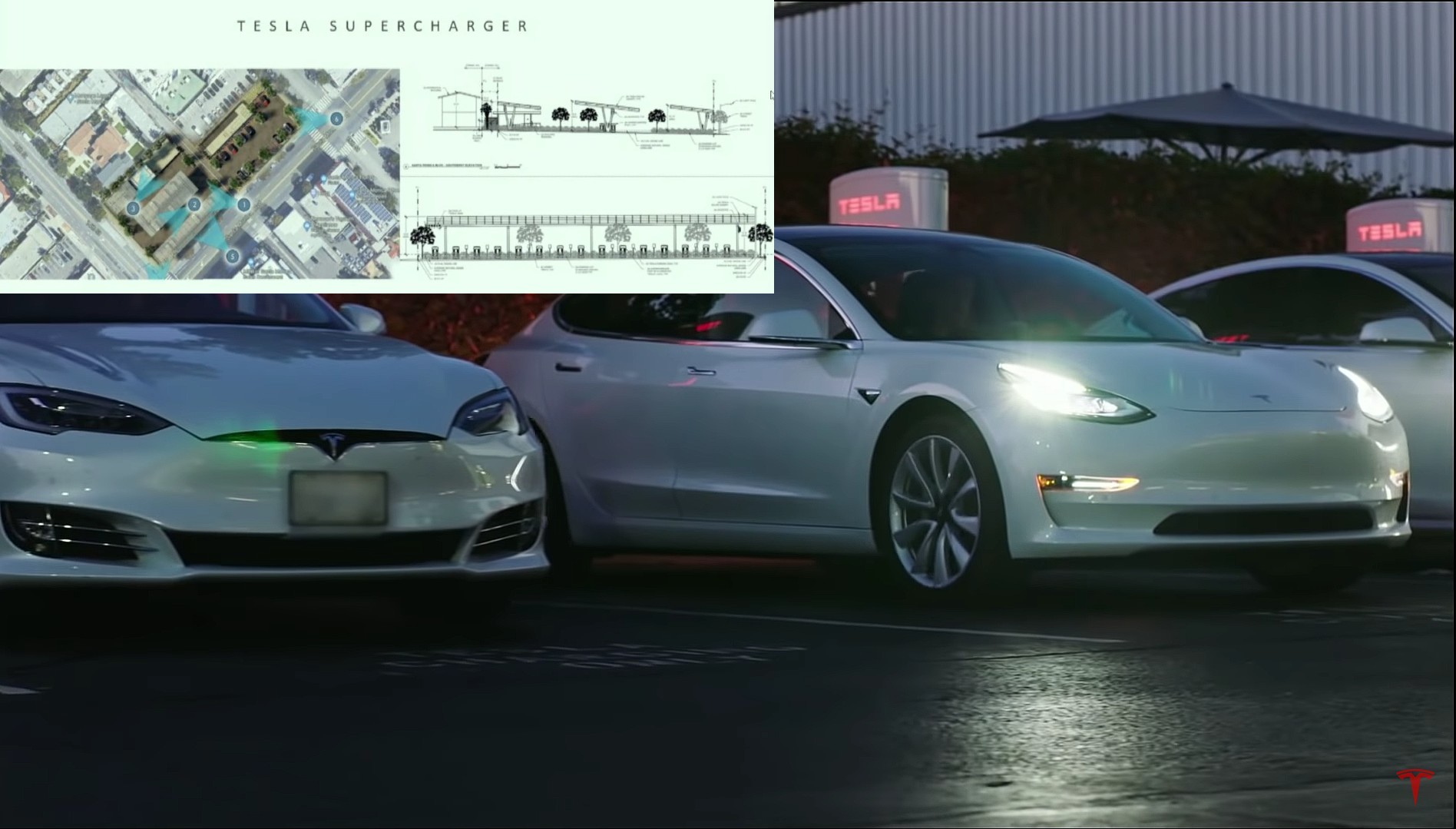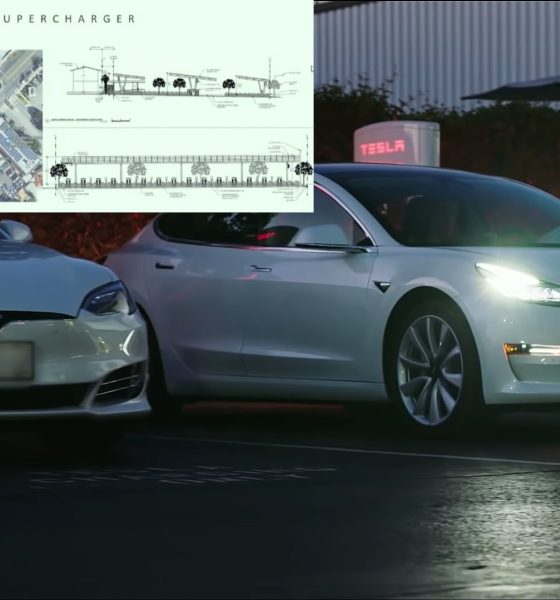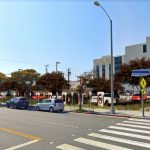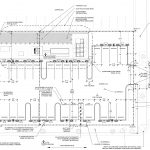

News
Tesla Supercharger V3 station with 62 stalls in Santa Monica gains approval despite objections
Tesla’s largest Supercharger V3 station to date has taken a definitive step forward, with the Santa Monica Planning Commission approving the 62-stall rapid-charging facility in a 5-2 vote. The approval came following three hours of discussions and questions, which included some interesting points against the Supercharger V3 site.
The 62-stall Supercharger V3 station, located at 1401 Santa Monica Boulevard, would feature two lots split in the middle by an alley. The west lot of the station will include 36 Supercharger V3 stalls, while its east side will house the remaining 26. The project will also include solar arrays on the west lot, battery storage units, and a restroom that is accessed by a code.
- Credit: DriveTeslaCanada
- Credit: DriveTeslaCanada
What was rather remarkable was that the Santa Monica Planning Commission took about three hours discussing the proposed rapid charging facility’s advantages and disadvantages. Several officials expressed their opposition to the Supercharger V3 station, and their reasons were unprecedented, at least to some degree.
Among the concerns brought up was the possible fan noise from the Supercharger stations and how it may disturb local residents in the area. Other commissioners expressed their concern about Tesla drivers charging at night who may play their “radios” very loudly and wake up people nearby. In this light, some commissioners asked why Tesla engineers could not use their tech to geofence the charging location to limit the vehicles’ “radio” volume. It was also hinted that Tesla contribute funds to help the city address its housing shortage.
- The plans for the 36 Stall Supercharger lot at 1401 Santa Monica Boulevard in Los Angeles. (Santa Monica Planning Commission)
- The plans for the 36 Stall Supercharger lot at 1401 Santa Monica Boulevard in Los Angeles. (Santa Monica Planning Commission)
Other concerns against the proposed facility involved the fact that the Supercharger V3 station may attract the homeless to the site, likely due to its restroom. There were also concerns about the number of stalls in the Supercharger, with one commissioner asking why Tesla couldn’t just build fewer stalls and have EV owners make appointments. Commissioner Ellis Raskin, for his part, suggested that the Supercharger V3 station was a project for the rich. “You all know I’m an environmentalist, but I’m not in support. This (project) supports the rich,” Raskin said.
Despite all these concerns and opposition, the Santa Monica Planning Commission nevertheless approved the 62-stall Tesla Supercharger V3 station, which would be one of the company’s biggest V3 sites to date. A good reason for this may very well be the efforts of Tesla employees Noelani Derrickson and Nadir Hossain, both of whom addressed the Planning Commissions’ concerns with the utmost patience and respect. Tesla owner Robert Rosenbloom, who listened in on the full three-hour session, remarked that ultimately, the commissioners’ opposition to the Supercharger V3 site was quite strange considering that Santa Monica is a reasonably progressive city with strong support for environmentalism, with the city even allowing electric vehicles with an HOV sticker to park on city streets without paying into parking meters.
Watch the Santa Monica Planning Commission’s vote on the proposed 62-stall Tesla Supercharger V3 station below.
After 3 long hours, the conditional use permit for the world’s largest V3 Tesla Supercharger has been approved in a 5-2 vote.
Credit to the two Tesla employees who fielded all those (many ridiculous) questions! pic.twitter.com/VykvpmDZAM
— Drive Tesla 🇨🇦 (@DriveTeslaca) March 4, 2021
Don’t hesitate to contact us for news tips. Just send a message to tips@teslarati.com to give us a heads up.

Elon Musk
Elon Musk and Tesla AI Director share insights after empty driver seat Robotaxi rides
The executives’ unoccupied tests hint at the rapid progress of Tesla’s unsupervised Robotaxi efforts.

Tesla CEO Elon Musk and AI Director Ashok Elluswamy celebrated Christmas Eve by sharing personal experiences with Robotaxi vehicles that had no safety monitor or occupant in the driver’s seat. Musk described the system’s “perfect driving” around Austin, while Elluswamy posted video from the back seat, calling it “an amazing experience.”
The executives’ unoccupied tests hint at the rapid progress of Tesla’s unsupervised Robotaxi efforts.
Elon and Ashok’s firsthand Robotaxi insights
Prior to Musk and the Tesla AI Director’s posts, sightings of unmanned Teslas navigating public roads were widely shared on social media. One such vehicle was spotted in Austin, Texas, which Elon Musk acknowleged by stating that “Testing is underway with no occupants in the car.”
Based on his Christmas Eve post, Musk seemed to have tested an unmanned Tesla himself. “A Tesla with no safety monitor in the car and me sitting in the passenger seat took me all around Austin on Sunday with perfect driving,” Musk wrote in his post.
Elluswamy responded with a 2-minute video showing himself in the rear of an unmanned Tesla. The video featured the vehicle’s empty front seats, as well as its smooth handling through real-world traffic. He captioned his video with the words, “It’s an amazing experience!”
Towards Unsupervised operations
During an xAI Hackathon earlier this month, Elon Musk mentioned that Tesla owed be removing Safety Monitors from its Robotaxis in Austin in just three weeks. “Unsupervised is pretty much solved at this point. So there will be Tesla Robotaxis operating in Austin with no one in them. Not even anyone in the passenger seat in about three weeks,” he said. Musk echoed similar estimates at the 2025 Annual Shareholder Meeting and the Q3 2025 earnings call.
Considering the insights that were posted Musk and Elluswamy, it does appear that Tesla is working hard towards operating its Robotaxis with no safety monitors. This is quite impressive considering that the service was launched just earlier this year.
Elon Musk
Starlink passes 9 million active customers just weeks after hitting 8 million
The milestone highlights the accelerating growth of Starlink, which has now been adding over 20,000 new users per day.

SpaceX’s Starlink satellite internet service has continued its rapid global expansion, surpassing 9 million active customers just weeks after crossing the 8 million mark.
The milestone highlights the accelerating growth of Starlink, which has now been adding over 20,000 new users per day.
9 million customers
In a post on X, SpaceX stated that Starlink now serves over 9 million active users across 155 countries, territories, and markets. The company reached 8 million customers in early November, meaning it added roughly 1 million subscribers in under seven weeks, or about 21,275 new users on average per day.
“Starlink is connecting more than 9M active customers with high-speed internet across 155 countries, territories, and many other markets,” Starlink wrote in a post on its official X account. SpaceX President Gwynne Shotwell also celebrated the milestone on X. “A huge thank you to all of our customers and congrats to the Starlink team for such an incredible product,” she wrote.
That growth rate reflects both rising demand for broadband in underserved regions and Starlink’s expanding satellite constellation, which now includes more than 9,000 low-Earth-orbit satellites designed to deliver high-speed, low-latency internet worldwide.
Starlink’s momentum
Starlink’s momentum has been building up. SpaceX reported 4.6 million Starlink customers in December 2024, followed by 7 million by August 2025, and 8 million customers in November. Independent data also suggests Starlink usage is rising sharply, with Cloudflare reporting that global web traffic from Starlink users more than doubled in 2025, as noted in an Insider report.
Starlink’s momentum is increasingly tied to SpaceX’s broader financial outlook. Elon Musk has said the satellite network is “by far” the company’s largest revenue driver, and reports suggest SpaceX may be positioning itself for an initial public offering as soon as next year, with valuations estimated as high as $1.5 trillion. Musk has also suggested in the past that Starlink could have its own IPO in the future.
News
NVIDIA Director of Robotics: Tesla FSD v14 is the first AI to pass the “Physical Turing Test”
After testing FSD v14, Fan stated that his experience with FSD felt magical at first, but it soon started to feel like a routine.

NVIDIA Director of Robotics Jim Fan has praised Tesla’s Full Self-Driving (Supervised) v14 as the first AI to pass what he described as a “Physical Turing Test.”
After testing FSD v14, Fan stated that his experience with FSD felt magical at first, but it soon started to feel like a routine. And just like smartphones today, removing it now would “actively hurt.”
Jim Fan’s hands-on FSD v14 impressions
Fan, a leading researcher in embodied AI who is currently solving Physical AI at NVIDIA and spearheading the company’s Project GR00T initiative, noted that he actually was late to the Tesla game. He was, however, one of the first to try out FSD v14.
“I was very late to own a Tesla but among the earliest to try out FSD v14. It’s perhaps the first time I experience an AI that passes the Physical Turing Test: after a long day at work, you press a button, lay back, and couldn’t tell if a neural net or a human drove you home,” Fan wrote in a post on X.
Fan added: “Despite knowing exactly how robot learning works, I still find it magical watching the steering wheel turn by itself. First it feels surreal, next it becomes routine. Then, like the smartphone, taking it away actively hurts. This is how humanity gets rewired and glued to god-like technologies.”
The Physical Turing Test
The original Turing Test was conceived by Alan Turing in 1950, and it was aimed at determining if a machine could exhibit behavior that is equivalent to or indistinguishable from a human. By focusing on text-based conversations, the original Turing Test set a high bar for natural language processing and machine learning.
This test has been passed by today’s large language models. However, the capability to converse in a humanlike manner is a completely different challenge from performing real-world problem-solving or physical interactions. Thus, Fan introduced the Physical Turing Test, which challenges AI systems to demonstrate intelligence through physical actions.
Based on Fan’s comments, Tesla has demonstrated these intelligent physical actions with FSD v14. Elon Musk agreed with the NVIDIA executive, stating in a post on X that with FSD v14, “you can sense the sentience maturing.” Musk also praised Tesla AI, calling it the best “real-world AI” today.












